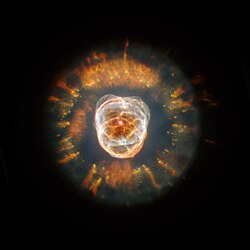
Eskimo Nebula
| Emission nebula | |
|---|---|
| Planetary nebula | |
 NGC 2392, the Eskimo Nebula by HST in 1999. | |
| Observation data: J2000 epoch | |
| Right ascension | 07h 29m 10.7669s[1] |
| Declination | +20° 54′ 42.488″[1] |
| Distance | 6520±560[2] ly |
| Apparent magnitude (V) | 10.1[1] |
| Apparent dimensions (V) | 48″; × 48″;[3] |
| Constellation | Gemini |
| Physical characteristics | |
| Radius | ≥0.34 ly[a] ly |
| Absolute magnitude (V) | ≤0.4[b] |
| Notable features | – |
| Designations | NGC 2392,[1] Caldwell 39, PN G197.8+17.3 Central Star: HIP 36369, HD 59088, TYC 1372-1287-1 |
The Eskimo Nebula (NGC 2392), also known as the Clown Face Nebula, Lion Nebula,[4] or Caldwell 39, is a bipolar[5] double-shell[6] planetary nebula (PN). It was discovered by astronomer William Herschel in 1787. The formation resembles a person's head surrounded by a parka hood. It is surrounded by gas that composed the outer layers of a Sun-like star. The visible inner filaments are ejected by a strong wind of particles from the central star. The outer disk contains unusual, light-year-long filaments.

NGC 2392 lies about 6500 light-years away, and is visible with a small telescope in the constellation of Gemini.

At the center of NGC 2392, there is an O-type star with a spectral type of O(H)6f.[7]

Historic data

The nebula was discovered by William Herschel on January 17, 1787, in Slough, England. He described it as "A star 9th magnitude with a pretty bright middle, nebulosity equally dispersed all around. A very remarkable phenomenon."[8] NGC 2392 WH IV-45 is included in the Astronomical League's Herschel 400 observing program.

Location

- NGC 2392 is located just east of δ Geminorum, just south of the ecliptic.
Naming controversy
On 11 August 2020, the IAU Working Group on Star Names (WGSN),[citation needed] NASA/IPAC Extragalactic Database (NED),[citation needed] and SIMBAD Astronomical Database (CDS) discontinued use of three nicknames that were perceived as offensive - "Eskimo Nebula", "Clown Face Nebula", and "Clownface Nebula" - and strongly recommended the nebula be referred to by its NGC designation in further publications.[9][1]

See also
Notes
References
- ^ a b c d e "NGC 2392". SIMBAD. Centre de données astronomiques de Strasbourg. Retrieved 2006-12-22.
- ^ Gaia Collaboration et al. (2018b): Summary of the contents and survey properties
- ^ O'Dell, C. R.; Balick, B.; Hajian, A. R.; Henney, W. J.; et al. (2002). "Knots in Nearby Planetary Nebulae". The Astronomical Journal. 123 (6): 3329–3347. Bibcode:2002AJ....123.3329O. doi:10.1086/340726.
- ^ Deep-Sky Companions: The Caldwell Objects, 2nd Edition, Stephen James O'Meara, 2016, p.181
- ^ O'dell, C. R.; Balick, B.; Hajian, A. R.; Henney, W. J.; et al. (2003). "Knots in Planetary Nebulae". In S. J. Arthur & W. J. Henney (ed.). Revista Mexicana de Astronomía y Astrofísica (Serie de Conferencias). Winds, Bubbles, and Explosions: a conference to honor John Dyson, Pátzcuaro, Michoacán, México, September 9–13, 2002. Vol. 15. pp. 29–33. Bibcode:2003RMxAC..15...29O. Archived from the original on 2018-05-01. Retrieved 2007-01-04.
- ^ Guerrero, M. A.; Chu, Y.-H.; Gruendl, R. A.; Meixner, M. (2005). "XMM-Newton detection of hot gas in the Eskimo Nebula: Shocked stellar wind or collimated outflows?". Astronomy and Astrophysics. 430 (3): L69–L72. arXiv:astro-ph/0412540. Bibcode:2005A&A...430L..69G. doi:10.1051/0004-6361:200400131. S2CID 6518963.
- ^ González-Santamaría, I.; Manteiga, M.; Manchado, A.; Ulla, A.; Dafonte, C.; López Varela, P. (2021). "Planetary nebulae in Gaia EDR3: Central star identification, properties, and binarity". Astronomy & Astrophysics. 656: A51. arXiv:2109.12114. Bibcode:2021A&A...656A..51G. doi:10.1051/0004-6361/202141916. S2CID 237940344.
- ^ The Scientific Papers of Sir William Herschel by J. L. E. Dreyer, Royal Society, London 1912
- ^ Talbert, Tricia (11 August 2020). "NASA to Reexamine Nicknames for Cosmic Objects". NASA. Retrieved 11 August 2020.
External links
- NGC 2392 on WikiSky: DSS2, SDSS, GALEX, IRAS, Hydrogen α, X-Ray, Astrophoto, Sky Map, Articles and images
- APOD (2003-12-07) – NGC 2392
- Eskimo Nebula Lowell Observatory
- The Structure & Evolution of the Eskimo Planetary Nebula University of Maryland Astronomy Department
- A Kinematic Determination of the Structure of the Double Ring Planetary Nebula NGC 2392, the Eskimo Astrophysical Journal v.362, p. 226 October 1990
- A Cat's Eye view of the Eskimo from Saturn Maria-Teresa Garc ́ıa-D ́ıaz, Jose-Alberto L ́opez, Wofgang Steffen, Michael G. Richer and Hortensia Riesgo, 2011
See what we do next...
OR
By submitting your email or phone number, you're giving mschf permission to send you email and/or recurring marketing texts. Data rates may apply. Text stop to cancel, help for help.
Success: You're subscribed now !

